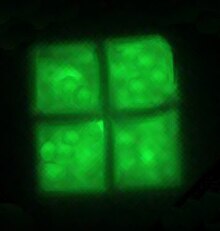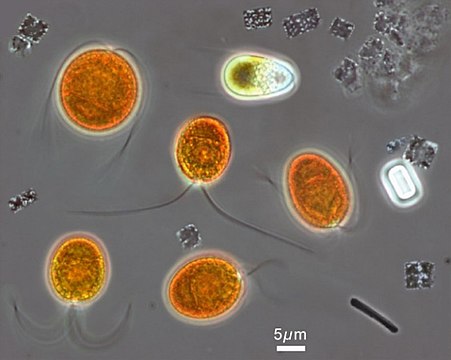Haloquadratum walsbyi
This article may be expanded with text translated from the corresponding article in French. (April 2018) Click [show] for important translation instructions.
|
| Haloquadratum walsbyi | |
|---|---|

| |
| Scientific classification | |
| Domain: | |
| Phylum: | |
| Class: | Halobacteria
|
| Order: | |
| Family: | |
| Genus: | |
| Species: | H. walsbyi
|
| Binomial name | |
| Haloquadratum walsbyi Burns et al. 2007
| |
Haloquadratum walsbyi is a species of archaea which was discovered in a brine pool in the Sinai peninsula of Egypt. It is noted for both its flat, square-shaped cells, and its unusual ability to survive in aqueous environments with high concentrations of sodium chloride and magnesium chloride.[1][2] The species' genus name Haloquadratum literally translates from Greek and Latin as "salt square".
Haloquadratum walsbyi is a phototrophic halophilic archaea. It was the only recognized species of the genus Haloquadratum until 1999 when Haloarcula quadrata was reported as recovered from a brine pool.[3] Haloquadratum walsbyi is very unusual in that it forms almost-perfectly square, flat-shaped cells.
The genus was observed for the first time in 1980 by a British microbiologist, Prof. Anthony E. Walsby, from samples taken from the Sabkha Gavish, a brine lake in southern Sinai, in Egypt, and has been described formally in 2007 by Burns et al. They are usually abundant in most salty environments. Attempts to cultivate them were unsuccessful until 2004 and resulted in the identification of haloarcula quadrata, another species of square archaea of the genus haloarcula, distinct from H. walsbyi, less abundant and genetically quite different.
The cells are large – 2 to 5 microns – but very thin – approximately 150 nanometers – and generally contain granules of polyhydroxyalkanoates. They also hold a large number of refractive vacuoles filled with gas that ensure buoyancy in an aqueous environment, and may help to position the cells to maximize the reception of light. They can gather in sheets up to 40 μm wide, but the connections between the cells are fragile and can easily be broken.
These organisms can be found in any stretch of very salty water. During the evaporation of seawater, calcium carbonate (CaCO3) and calcium sulfate (CaSO4) precipitate first, leading to a brine rich in sodium chloride NaCl. If evaporation continues, NaCl precipitates in the form of halite, leaving a brine rich in magnesium chloride (MgCl2). H. walsbyi prospers during the final phase of the precipitation of halite, and can constitute 80% of the biomass of this medium.
The genome of H. walsbyi has been completely sequenced, allowing access to a better understanding of the phylogenetic and taxonomic classification of this organism and its role in the ecosystem. A genomic comparison of Spanish and Australian isolates (strains HBSQ001 and C23T) strongly suggests a rapid global dispersion, as they are remarkably similar and have maintained the order of genes.
Its growth in the laboratory was obtained in a medium with very high chloride concentrations (greater than 2 mol · L−1 of MgCl2 and greater than 3 mol · L −1of NaCl ), making this organism among the most haloresistant known. Its optimum growth temperature is 40 °C.
 Optical phase-contrast microscopy image of a Haloquadratum walsbyi square cell. The numerous light dots are gas vesicles that allow flotation to the surface, most likely to acquire oxygen.[4]Scale bar 1 µm
Optical phase-contrast microscopy image of a Haloquadratum walsbyi square cell. The numerous light dots are gas vesicles that allow flotation to the surface, most likely to acquire oxygen.[4]Scale bar 1 µm
Microscopic image from the hypersaline Lake Tyrrell, in which orange chlorophyte Dunaliella salina can be tentatively identified, accompanied by a number of smaller Haloquadratum walsbyi, showing their flat square-shaped cells.
References[]
- ^ Oren, A.; Ventosa, A.; Gutierrez, M. C.; Kamekura, M. (1 July 1999). "Haloarcula quadrata sp. nov., a square, motile archaeon isolated from a brine pool in Sinai (Egypt)". International Journal of Systematic Bacteriology. 49 (3): 1149–1155. doi:10.1099/00207713-49-3-1149. PMID 10425773.
- ^ Bolhuis, Henk; Palm, Peter; Wende, Andy; Falb, Michaela; Rampp, Markus; Rodriguez-Valera, Francisco; Pfeiffer, Friedhelm; Oesterhelt, Dieter (2006-07-04). "The genome of the square archaeon Haloquadratum walsbyi : life at the limits of water activity". BMC Genomics. 7 (1): 169. doi:10.1186/1471-2164-7-169. ISSN 1471-2164. PMC 1544339. PMID 16820047.
- ^ Oren, A; Ventosa, A; Gutiérrez, MC; Kamekura, M (1999). "Haloarcula quadrata sp. nov., a square, motile archaeon isolated from a brine pool in Sinai (Egypt)". Int J Syst Bacteriol. 49 Pt 3 (3): 1149–55. doi:10.1099/00207713-49-3-1149. PMID 10425773.
- ^ Noor MAF, Parnell RS, Grant BS (2011) "Morphological and Structural Aspects of the Extremely Halophilic Archaeon Haloquadratum walsbyi" PLoS ONE, 6(4): e18653. {{doi:10.1371/journal.pone.0003142}}
Further reading[]
- Lobasso, Simona; Lopalco, Patrizia; Vitale, Rita; Saponetti, Matilde Sublimi; Capitanio, Giuseppe; Mangini, Vincenzo; Milano, Francesco; Trotta, Massimo; Corcelli, Angela (9 February 2012). "The Light-Activated Proton Pump Bop I of The Archaeon Haloquadratum walsbyi". Photochemistry and Photobiology. 88 (3): 690–700. doi:10.1111/j.1751-1097.2012.01089.x. PMID 22248212. S2CID 41934280.
External links[]
- Halobacteria
- Archaea described in 2007

